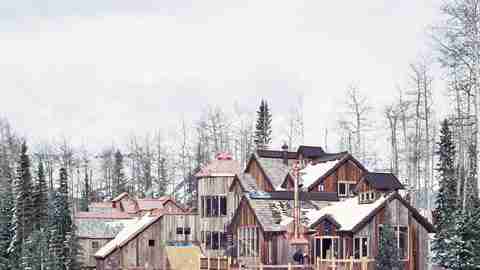Rocky Mountain High Style
View Slideshow

It's not uncommon for people at higher altitudes to report the experience of hallucinations. Up above 8,000 feet or so, the oxygen-deprived mind can suddenly find itself robbed of enough strength to keep prankish eyes from playing tricks.
Surely that's the only explanation for this unlikely spectacle atop a snowy Colorado mountain, nearly 10,000 feet above sea level. Honestly, how on earth could this late-19th century Egyptian Revival billiard table, emblazoned with palm tree marquetry, have gotten up here? What is that 1920s Chinese armoire doing so far from home? Whence these William Morris chairs?
"Wood is just a natural for the mountains," Samuel Botero says. "It feels very warm."
There remains one other possibility Samuel Botero has been here. Not long ago the Colombian-born, Manhattan-based designer—who combines a consummate knowledge of antiques with an unabashedly romantic love of color—completed a project near the picturesque ski village of Telluride.
Botero confesses that he doesn't ski. But, he's quick to add, "I love the mountains; I was born in the Andes." And with that upbringing, perhaps, came an inborn understanding of which styles are most suited to a place like Telluride, which rests serenely in a box canyon among the 13,000-foot peaks of the San Juans.
Warmth, not surprisingly, was the brief. Still, the archetypal ski-lodge trappings—walls of knotty pine, a display of antlers above the hearth— wouldn't do here. Both client and designer were after something equally comfortable yet more refined a look rooted in two of the 19th century's greatest stylistic imports, Victorian and the Arts and Crafts Movement, but flexible enough to accommodate the client's many collections, including her prodigious collection of art from the American West.
"We didn't want to do an exact copy of an Arts and Crafts interior," says Botero, "but we were definitely influenced by that style—its spirit of detailing, and especially its vocabulary of wood. Wood is just a natural for the mountains; it feels very warm." To temper its hardness, he imagined filling the house with "rich, colorful fabrics velvets, wonderful cashmeres and wools, but always keeping it comfortable."
The look is rooted in two of the 19th century's greatest styles, Victorian and the Arts and Crafts Movement.
The residence, built in the spirit of miners' cabins, was in the process of a major renovation and expansion by architect John Brons, giving Botero and his client a series of tantalizingly blank slates. Once construction was completed, the designer began filling up rooms with the fruits of his Manhattan shopping trips. Soon the living room could boast much more than an enviable view of the aspen-covered slopes the aforementioned billiard table, an English Renaissance-style octagonal table and a pair of 19th-century Savonarola chairs. For the kitchen, Botero designed a baker's rack, and for the adjacent family room, a sofa with built-in bookcases; both pieces marry utility with a rustic beauty in a manner Greene and Greene would have admired.
People who live near ski lifts tend to have frequent guests, and at the end of a 36-foot-long hallway leading away from the main house are guest quarters, complete with their own generous living area. A William Morris chair by the fireplace provides the perfect après-ski sanctuary; add a good book and a cup of steaming coffee, and it presents a compelling argument for skipping the action on the slopes altogether.
"Have nothing in your house that you do not know to be useful or believe to be beautiful." Samuel Botero has fully absorbed this dictum, attributed to Morris, the father of the English Arts and Crafts Movement. To solve the problem of dryness—another fact of life at 9,600 feet—he and Brons collaborated on a useful and beautiful humidifier a three-story water feature that cascades down the entire length of a wall, next to the staircase. A hallucination? No, just another pleasant surprise.
After all, what good is a mountain hideaway without a scenic waterfall?